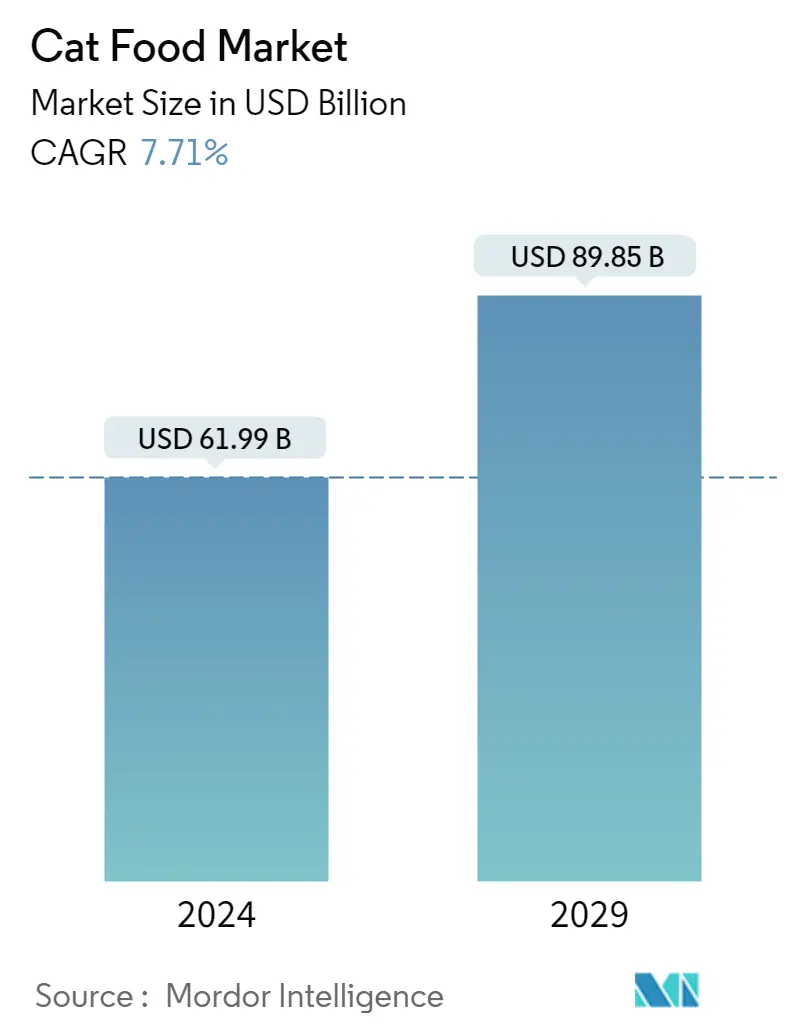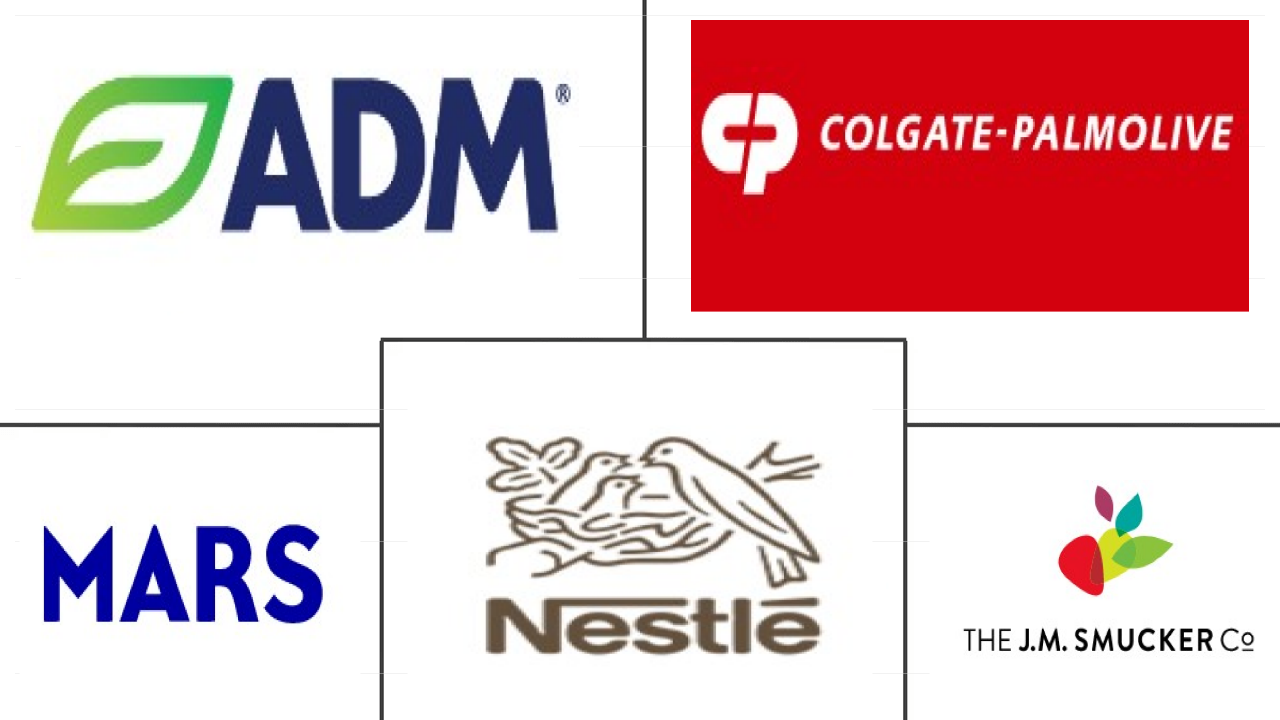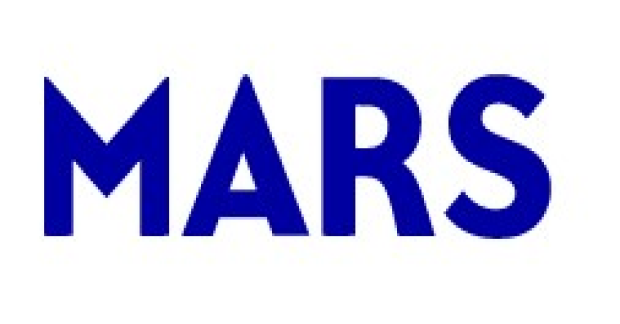Market Size of cat food Industry

| Icons | Lable | Value |
|---|---|---|
|
|
Study Period | 2017 - 2029 |
|
|
Market Size (2024) | USD 61.99 Billion |
|
|
Market Size (2029) | USD 89.85 Billion |
|
|
Largest Share by Pet Food Product | Food |
|
|
CAGR (2024 - 2029) | 7.71 % |
|
|
Largest Share by Region | North America |
|
|
Market Concentration | Low |
Major Players |
||

|
||
|
*Disclaimer: Major Players sorted in no particular order |
Cat Food Market Analysis
The Cat Food Market size is estimated at USD 61.99 billion in 2024, and is expected to reach USD 89.85 billion by 2029, growing at a CAGR of 7.71% during the forecast period (2024-2029).
61.99 Billion
Market Size in 2024 (USD)
89.85 Billion
Market Size in 2029 (USD)
8.92 %
CAGR (2017-2023)
7.71 %
CAGR (2024-2029)
Largest Market by Product
72.85 %
value share, Food, 2022
In line with the growing cat population and with food products serving as the primary source of nutrition for cats, pet owners are spending more on diverse food products.
Largest Market by Region
39.88 %
value share, North America, 2022
High cat ownership rates and increased purchasing of wet cat food and cat treats formulated with functional ingredients have contributed to North America’s leading market position.
Fastest-growing Market by Product
9.44 %
Projected CAGR, Pet Treats, 2023-2029
The growing demand for crunchy, dental, and freeze-dried treats is driving the market's growth, as these treats often help in training and supporting the well-being of cats.
Fastest-growing Market by Region
12.77 %
Projected CAGR, South America, 2023-2029
The increasing pet ownership rates and growing consumer spending power on premium and nutritional pet food products for cats are driving the segment’s growth.
Leading Market Player
15.64 %
market share, Mars Incorporated, 2022

Mars, Incorporated is the market leader due to its focus on product innovation and the expansion of its manufacturing bases in countries such as the United States, Mexico, China, and India.
Higher usage of commercial products and pet humanization are driving the cat food market
- Globally, cats are one of the major pets adopted and are getting popular due to their low maintenance, adaptability to small living spaces, and being treated as a sign of fortune in European countries. In 2022, cats held 32.3% of the global pet food market, which increased by 55.8% between 2017 and 2022 due to an increase of 18.8% in the cat population.
- In 2022, the food product segment was the largest segment of the global cat food market, with a market value of USD 38.62 billion. It is due to the regular feeding of food products to meet their daily nutritional needs, which act as a staple food for cats. Moreover, wet pet food dominated over dry pet food as it accounted for a 53.6% share in 2022 due to its palatability, helps in weight management, and is easy to digest for cats.
- The treats segment was the second largest segment, with a market value of USD 7.19 billion in 2022, followed by veterinary diets (USD 5.76 billion) and nutraceuticals/supplements (USD 1.45 billion). It is expected to be the fastest-growing segment, recording a CAGR of 8.0% during the forecast period due to its advantages, such as positive reinforcement during training sessions, a source of mental stimulation and entertainment, and strengthening the bond between the pet and its parent.
- The growing adoption of veterinary diets as a preventive approach for cats and the increasing incidence of diseases such as renal, urinary tract, and diabetes in cats are creating demand for veterinary diets. It is the second fastest-growing segment, and it is expected to record a CAGR of 7.5% during the forecast period.
- The increase in population, increased awareness of preventive approaches, and rise in pet humanization are the factors expected to drive the market at a CAGR of 6.8% during the forecast period.
Increasing cat adoption and the pet humanization trend are driving the global market
- Cats are rapidly growing in popularity as traditional pets worldwide with the growing urbanization as people living in urban areas seek smaller pets with lesser maintenance suitable for compact houses and busy lifestyles. In 2022, the cat food market accounted for 32.3% of the global pet food market, which grew by 34.7% between 2017 and 2021. This growth is associated with the increase in the usage of commercial pet food products with the growing pet humanization trend worldwide, making cats a preferred pet among pet owners.
- North America and Europe were the major regions in the global cat food market, accounting for USD 21.1 billion and USD 19.4 billion in 2022, respectively. The higher share of these regions was because of the higher premiumization trend among its countries, which are highly developed in terms of the pet food market. These countries include the United States, Germany, and France, which held significant shares of 35.3%, 6%, and 5.3% of the global cat food market in 2022, respectively. The majority of pet owners seek products made with natural or organic ingredients, single meat sources, and grain-free that are considered premium.
- In South America, the highest cat adoptions are in Brazil and Argentina. Moreover, the increasing urbanization is estimated to register a CAGR of 12.8% during the forecast period. Cultural factors are also leading to the preference for cats among the younger population in Asia-Pacific, especially in Indonesia and China.
- The adoption of cats among the urban population and the growing pet humanization trend are anticipated to drive the global cat food market, which is expected to register a CAGR of 6.8% during the forecast period.
Cat Food Industry Segmentation
Food, Pet Nutraceuticals/Supplements, Pet Treats, Pet Veterinary Diets are covered as segments by Pet Food Product. Convenience Stores, Online Channel, Specialty Stores, Supermarkets/Hypermarkets are covered as segments by Distribution Channel. Africa, Asia-Pacific, Europe, North America, South America are covered as segments by Region.
- Globally, cats are one of the major pets adopted and are getting popular due to their low maintenance, adaptability to small living spaces, and being treated as a sign of fortune in European countries. In 2022, cats held 32.3% of the global pet food market, which increased by 55.8% between 2017 and 2022 due to an increase of 18.8% in the cat population.
- In 2022, the food product segment was the largest segment of the global cat food market, with a market value of USD 38.62 billion. It is due to the regular feeding of food products to meet their daily nutritional needs, which act as a staple food for cats. Moreover, wet pet food dominated over dry pet food as it accounted for a 53.6% share in 2022 due to its palatability, helps in weight management, and is easy to digest for cats.
- The treats segment was the second largest segment, with a market value of USD 7.19 billion in 2022, followed by veterinary diets (USD 5.76 billion) and nutraceuticals/supplements (USD 1.45 billion). It is expected to be the fastest-growing segment, recording a CAGR of 8.0% during the forecast period due to its advantages, such as positive reinforcement during training sessions, a source of mental stimulation and entertainment, and strengthening the bond between the pet and its parent.
- The growing adoption of veterinary diets as a preventive approach for cats and the increasing incidence of diseases such as renal, urinary tract, and diabetes in cats are creating demand for veterinary diets. It is the second fastest-growing segment, and it is expected to record a CAGR of 7.5% during the forecast period.
- The increase in population, increased awareness of preventive approaches, and rise in pet humanization are the factors expected to drive the market at a CAGR of 6.8% during the forecast period.
| Pet Food Product | |||||||||||
| |||||||||||
| |||||||||||
| |||||||||||
|
| Distribution Channel | |
| Convenience Stores | |
| Online Channel | |
| Specialty Stores | |
| Supermarkets/Hypermarkets | |
| Other Channels |
| Region | |||||||||||||||
| |||||||||||||||
| |||||||||||||||
| |||||||||||||||
| |||||||||||||||
|
Cat Food Market Size Summary
The cat food market is experiencing significant growth, driven by the increasing popularity of cats as pets globally. This trend is attributed to factors such as the low maintenance requirements of cats, their adaptability to smaller living spaces, and cultural perceptions of cats as symbols of fortune, particularly in European countries. The market is characterized by a strong demand for food products, with wet pet food leading due to its palatability and digestive benefits. The treats segment is also gaining traction, fueled by their role in training and bonding with pets. Additionally, the adoption of veterinary diets is on the rise, driven by the need to address health issues like renal and urinary tract diseases in cats. The market's expansion is further supported by the pet humanization trend, where pets are increasingly seen as family members, prompting higher expenditure on premium and specialized pet food products.
Regionally, North America and Europe dominate the cat food market, benefiting from a trend towards premiumization and a preference for natural and organic ingredients. The United States, Germany, and France are key players in this space, with significant market shares. In South America, Brazil and Argentina lead in cat adoptions, while in the Asia-Pacific region, countries like Indonesia and China are witnessing a cultural shift towards cat ownership among the younger population. The COVID-19 pandemic has also contributed to increased cat adoptions, particularly in the United States, as people sought companionship during lockdowns. The market is fragmented, with major companies like ADM, Colgate-Palmolive Company, Mars Incorporated, Nestle, and The J. M. Smucker Company holding significant shares. These companies are actively introducing new products to cater to the evolving preferences of pet owners, emphasizing the importance of quality and specialized nutrition for cats.
Cat Food Market Size - Table of Contents
-
1. MARKET SEGMENTATION (includes market size in Value in USD and Volume, Forecasts up to 2029 and analysis of growth prospects)
-
1.1 Pet Food Product
-
1.1.1 Food
-
1.1.1.1 By Sub Product
-
1.1.1.1.1 Dry Pet Food
-
1.1.1.1.1.1 By Sub Dry Pet Food
-
1.1.1.1.1.1.1 Kibbles
-
1.1.1.1.1.1.2 Other Dry Pet Food
-
-
-
1.1.1.1.2 Wet Pet Food
-
-
-
1.1.2 Pet Nutraceuticals/Supplements
-
1.1.2.1 By Sub Product
-
1.1.2.1.1 Milk Bioactives
-
1.1.2.1.2 Omega-3 Fatty Acids
-
1.1.2.1.3 Probiotics
-
1.1.2.1.4 Proteins and Peptides
-
1.1.2.1.5 Vitamins and Minerals
-
1.1.2.1.6 Other Nutraceuticals
-
-
-
1.1.3 Pet Treats
-
1.1.3.1 By Sub Product
-
1.1.3.1.1 Crunchy Treats
-
1.1.3.1.2 Dental Treats
-
1.1.3.1.3 Freeze-dried and Jerky Treats
-
1.1.3.1.4 Soft & Chewy Treats
-
1.1.3.1.5 Other Treats
-
-
-
1.1.4 Pet Veterinary Diets
-
1.1.4.1 By Sub Product
-
1.1.4.1.1 Diabetes
-
1.1.4.1.2 Digestive Sensitivity
-
1.1.4.1.3 Oral Care Diets
-
1.1.4.1.4 Renal
-
1.1.4.1.5 Urinary tract disease
-
1.1.4.1.6 Other Veterinary Diets
-
-
-
-
1.2 Distribution Channel
-
1.2.1 Convenience Stores
-
1.2.2 Online Channel
-
1.2.3 Specialty Stores
-
1.2.4 Supermarkets/Hypermarkets
-
1.2.5 Other Channels
-
-
1.3 Region
-
1.3.1 Africa
-
1.3.1.1 By Country
-
1.3.1.1.1 South Africa
-
1.3.1.1.2 Rest of Africa
-
-
-
1.3.2 Asia-Pacific
-
1.3.2.1 By Country
-
1.3.2.1.1 Australia
-
1.3.2.1.2 China
-
1.3.2.1.3 India
-
1.3.2.1.4 Indonesia
-
1.3.2.1.5 Japan
-
1.3.2.1.6 Malaysia
-
1.3.2.1.7 Philippines
-
1.3.2.1.8 Taiwan
-
1.3.2.1.9 Thailand
-
1.3.2.1.10 Vietnam
-
1.3.2.1.11 Rest of Asia-Pacific
-
-
-
1.3.3 Europe
-
1.3.3.1 By Country
-
1.3.3.1.1 France
-
1.3.3.1.2 Germany
-
1.3.3.1.3 Italy
-
1.3.3.1.4 Netherlands
-
1.3.3.1.5 Poland
-
1.3.3.1.6 Russia
-
1.3.3.1.7 Spain
-
1.3.3.1.8 United Kingdom
-
1.3.3.1.9 Rest of Europe
-
-
-
1.3.4 North America
-
1.3.4.1 By Country
-
1.3.4.1.1 Canada
-
1.3.4.1.2 Mexico
-
1.3.4.1.3 United States
-
1.3.4.1.4 Rest of North America
-
-
-
1.3.5 South America
-
1.3.5.1 By Country
-
1.3.5.1.1 Argentina
-
1.3.5.1.2 Brazil
-
1.3.5.1.3 Rest of South America
-
-
-
-
Cat Food Market Size FAQs
How big is the Cat Food Market?
The Cat Food Market size is expected to reach USD 61.99 billion in 2024 and grow at a CAGR of 7.71% to reach USD 89.85 billion by 2029.
What is the current Cat Food Market size?
In 2024, the Cat Food Market size is expected to reach USD 61.99 billion.

